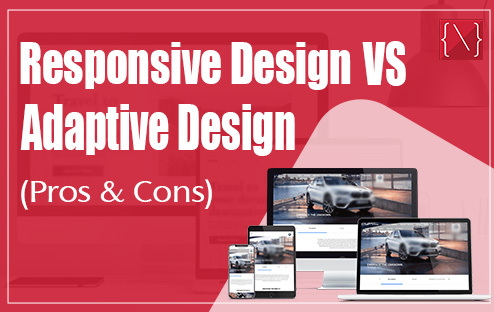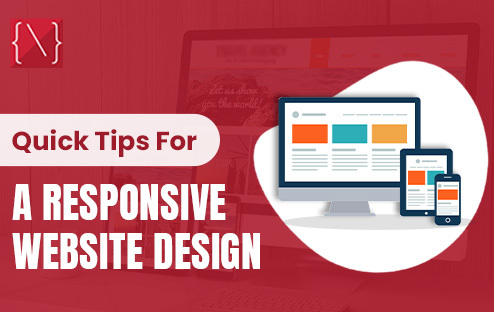
In today’s multi-device world, ensuring your website delivers a seamless experience across desktops, tablets, and smartphones is no longer a luxury, it’s a necessity. This is where responsive design and adaptive design come into play. Both approaches aim to create websites that adapt to different screen sizes, but they achieve this in fundamentally different ways. Choosing the right approach for your website depends on your specific needs, target audience, and budget. Let’s go deeper into the pros and cons of each method to help you make an informed decision.
Responsive Design: Fluid and Flexible
Responsive design is the current industry standard. It utilizes a single website layout that adjusts and reflows based on the user’s screen size. This is achieved through the use of CSS media queries, which are essentially sets of rules that dictate how the website elements should behave at different screen widths.
Pros of Responsive Design:–
- Reduced Development and Maintenance Costs: You only need to build and maintain one website, making it a more cost-effective solution.
- Flexibility: Responsive layouts can adapt to an infinite number of screen sizes, future-proofing your website for new devices and resolutions.
- Search Engine Optimization (SEO) Friendly: Search engines like Google favor mobile-friendly websites, and responsive design inherently delivers a good mobile experience.
- Consistent User Experience: Users will encounter the same branding and content across all devices, fostering a sense of familiarity and trust.
Cons of Responsive Design:–
- Potentially Less Control Over User Experience: Since the layout adapts automatically, you might have less granular control over how elements appear on specific devices.
- Complexity for Complex Layouts: Websites with intricate layouts or heavy use of multimedia might require more development effort to ensure a smooth responsive experience.
Adaptive Design: Tailored Experiences
Adaptive design, on the other hand, utilizes multiple pre-defined layouts optimized for specific device groups (e.g., desktops, tablets, mobiles). When a user accesses the website, their device is detected, and the most suitable layout is served.
Pros of Adaptive Design:–
- Highly Optimized User Experience: With dedicated layouts for different devices, you can create a highly tailored experience for each user group, potentially leading to better engagement.
- Faster Loading Times: Since users only receive the layout designed for their device, there’s less content to load, potentially improving website speed.
- Ideal for Complex Layouts: Websites with rich media or intricate layouts might benefit from the more structured approach of adaptive design.
Cons of Adaptive Design:–
- Increased Development and Maintenance Costs: Building and maintaining multiple layouts requires more time and resources.
- Limited Scalability: New device sizes or resolutions might require creating entirely new layouts to accommodate them.
- Potential for Inconsistent User Experience: The user experience can vary depending on the device used, which might be jarring for some users.
Choosing Between Responsive and Adaptive Design
So, which approach is right for you? Here are some factors to consider:
- Website Complexity: For simpler websites with straightforward layouts, responsive design is a great choice. For complex websites with rich media, adaptive design might offer advantages.
- Target Audience: If your target audience primarily uses desktops, responsive design might suffice. If your audience heavily relies on mobile devices, adaptive design might be worth considering.
- Budget: Responsive design is generally more cost-effective due to the need to maintain only one website.
- Future-Proofing: Responsive design is more adaptable to future screen sizes and devices.
Ultimately, the best approach depends on your specific needs and priorities. Consider your budget, target audience, and website complexity to make an informed decision.
Conclusion
Both responsive design and adaptive website design have their merits and drawbacks. By understanding the strengths and weaknesses of each approach, you can choose the method that best serves your website’s needs and delivers an optimal user experience across all devices. If you’re still unsure, consulting with a web design professional can help you make the best choice for your unique situation.
ALSO READ: Web 2.0 vs Web 3.0- Know The Differences & Similarities

In today’s digital age, having a responsive website design is crucial for any business or organization. With the majority of internet users accessing websites through their mobile devices, having a website that adapts to different screen sizes and devices is essential for a positive user experience. In this blog, we will discuss some quick tips for creating a responsive website design that will help you attract and retain more visitors.
1. Use a Mobile-First Approach: When designing a responsive website, it is important to start with a mobile-first approach. This means designing the website for mobile devices first and then scaling it up for larger screens. This approach ensures that the website is optimized for smaller screens and then adjusted for larger ones, rather than the other way around.
2. Keep it Simple: A cluttered and complicated website can be overwhelming for users, especially on mobile devices. Keep your design simple and clean, focusing on the most important elements. This will make it easier for users to navigate and find the information they are looking for.
3. Utilize Responsive Images: Images play a crucial role in website design, but they can also slow down the loading speed of a website. To ensure a fast and responsive website, use images that are optimized for different screen sizes. This will allow the website to load quickly on all devices without compromising on the quality of the images.
4. Use Scalable Vector Graphics (SVGs): SVGs are a great option for website design as they can be scaled up or down without losing their quality. This means that they will look crisp and clear on all screen sizes, making them perfect for responsive designs.
5. Make Use of CSS Media Queries: CSS media queries allow you to specify different styles for different screen sizes. This makes it easier to create a responsive design that adapts to different devices. You can use media queries to adjust font sizes, layouts, and other design elements according to the screen size.
6. Test, Test, Test: It is important to test your website on different devices and screen sizes to ensure that it is responsive and functioning properly. This will help you identify any design flaws or issues that need to be addressed.
7. Use a Responsive Framework: If you are not comfortable with coding and designing a responsive website from scratch, you can use a responsive framework. These frameworks provide pre-built templates and components that can be easily customized to create a responsive design.
8. Don’t Forget about Navigation: Navigation is an essential aspect of website design, and it becomes even more crucial for a responsive website. Make sure that your navigation is user-friendly and easy to use on all devices. A hamburger menu or a simple navigation bar can work well for mobile devices.
9. Optimize for Touchscreen Devices: With the rise of touchscreen devices, it is important to design your website with touch interactions in mind. This means providing enough space between clickable elements and using larger buttons and links for easy navigation on smaller screens.
10. Keep the User in Mind: Ultimately, the key to a successful responsive website design is keeping the user in mind. Put yourself in the shoes of your target audience and think about what they would want to see and how they would want to navigate through your website. This will help you create a design that is user-friendly and responsive.
In conclusion, having a responsive website design is crucial for the success of your online presence. By following these quick tips, you can create a website that adapts to different devices and screen sizes, providing a positive user experience for all your visitors. So, make sure to keep these tips in mind when designing your next website.

In the ever-evolving digital landscape, the success of an eCommerce website relies on numerous factors, with User Experience (UX) design playing a pivotal role. As eCommerce solutions continue to shape the way we shop and sell online, the importance of creating a seamless and enjoyable user experience cannot be overstated. In this blog, we will explore the significant role that UX design plays in eCommerce website development, and how it can make or break the success of an online store.
Understanding UX Design
Before delving into its role in eCommerce website development, it’s essential to understand what UX design is. User Experience design is the process of creating a website or application that provides a positive and meaningful experience for the users. This encompasses various aspects, including usability, accessibility, aesthetics, and overall user satisfaction.
First Impressions Matter
When it comes to eCommerce, first impressions matter significantly. The design and layout of your online store can either captivate or deter potential customers. A well-thought-out UX design ensures that the website is visually appealing, easy to navigate, and consistent with your brand identity. These elements can make users feel more comfortable and confident, increasing the chances of conversion.
Navigation and Accessibility
Navigation is a key component of any eCommerce website. If customers find it difficult to navigate through your site, they are likely to abandon their shopping carts. UX designers focus on creating a clear and intuitive navigation structure, simplifying the shopping process. The site should be organized logically, with a user-friendly menu, search function, and filters to help customers find what they are looking for.
Accessibility is another crucial factor in UX design. Your eCommerce website should be accessible to everyone, including people with disabilities. Ensuring that the website complies with accessibility standards not only opens up your market to a broader audience but also helps in maintaining a positive brand image.
ALSO READ: Shopify or Magento Which One to Choose For Your eCommerce Development
Mobile Responsiveness
In today’s world, more and more people are shopping through their mobile devices. A responsive design is a necessity for an eCommerce website, ensuring that it adapts seamlessly to different screen sizes and devices. A poor mobile experience can lead to a high bounce rate and lost sales. UX designers prioritize mobile responsiveness to create a consistent and enjoyable shopping experience across all platforms.
Loading Speed and Performance
In the fast-paced digital age, nobody has the patience for slow-loading websites. Speed matters, not only for user satisfaction but also for search engine rankings. UX designers work on optimizing website performance to ensure quick loading times, smooth transitions, and minimal downtime. A faster website can significantly improve the user experience and contribute to higher conversion rates.
Trust and Credibility
An essential part of eCommerce is establishing trust with your customers. The design of your website can significantly influence how trustworthy and credible your online store appears. A well-designed eCommerce website with clear product descriptions, high-quality images, and secure payment options can instill confidence in your potential customers. UX designers work on building trust through the design elements, fostering a positive relationship between the website and its visitors.
User-Friendly Checkout Process
The checkout process is a make-or-break moment in eCommerce. A complicated or confusing checkout process can lead to cart abandonment. UX designers streamline the checkout process, making it as simple and user-friendly as possible. This includes features like guest checkout, progress indicators, and a variety of payment options to cater to different preferences.
Feedback and Continuous Improvement
One of the essential aspects of UX design is its iterative nature. UX designers don’t stop at the initial launch of the website. They continually collect and analyze user feedback, track user behavior, and make data-driven improvements to enhance the overall experience. This ongoing process of refinement ensures that the website remains competitive and meets the evolving needs of the users.
Conclusion
In the world of eCommerce website development, the role of UX design cannot be overstated. It is the driving force that ensures your online store is not just functional but also user-friendly, visually appealing, and efficient. A well-designed eCommerce website can improve customer satisfaction, increase conversion rates, and build trust and credibility for your brand. As eCommerce solutions continue to evolve, focusing on UX design will remain critical in achieving and maintaining success in the online marketplace. So, if you’re planning to build or revamp your eCommerce website, make sure to prioritize UX design throughout the process.

In today’s fast-paced digital landscape, having a website is no longer an option; it’s a necessity. Whether you’re a small business owner, a blogger, or a large corporation, a well-maintained website is crucial for success. While many invest significant time and resources in the initial development phase, it’s equally important to understand the significance of ongoing website maintenance.
Here are three key reasons why website maintenance should be a priority after the web development phase:
1. Security Concerns:
One of the most critical reasons to prioritize website maintenance is security. The internet is rife with cyber threats, and without proper maintenance, your website becomes vulnerable to attacks. Outdated software, plugins, and themes are common targets for hackers.
Regular updates to your website’s content management system (CMS), plugins, and themes are essential to patch vulnerabilities and protect against potential breaches. Additionally, implementing security measures like firewalls and SSL certificates can further safeguard your site and the sensitive information of your visitors.
By keeping your website up-to-date and secure, you not only protect your own interests but also establish trust with your audience. When visitors know they can browse your site safely, they are more likely to engage, convert, and return.
2. Optimal User Experience:
User experience (UX) is a critical factor in the success of any website. A well-maintained site ensures that visitors can navigate easily, find information quickly, and have a seamless browsing experience across different devices.
Over time, broken links, outdated content, and slow-loading pages can significantly impact user satisfaction. By conducting regular checks and updates, you can identify and rectify these issues before they negatively impact your audience.
Furthermore, website maintenance allows for the implementation of responsive design practices. With the increasing use of mobile devices for internet browsing, ensuring that your site is mobile-friendly is paramount. A well-maintained website adapts to different screen sizes and resolutions, providing an optimal experience for all users.
3. Search Engine Optimization (SEO) Benefits:
Search engines like Google and Bing continually update their algorithms to provide the best results to users. To maintain or improve your search rankings, it’s crucial to stay current with these changes.
Website maintenance includes tasks such as updating meta tags, optimizing images, and ensuring that your content is relevant and up-to-date. Regularly auditing and improving your website’s SEO not only helps in maintaining your current rankings but also positions your site for higher visibility in search results.
Additionally, a well-maintained website tends to load faster, which is a known factor in search engine rankings. By optimizing images, minimizing code, and utilizing caching techniques, you can improve your site’s performance and increase its chances of ranking higher in search results.
In conclusion, website maintenance is not an optional task but a crucial part of managing a successful online presence. By prioritizing security, ensuring optimal user experience, and reaping the benefits of SEO, you’re not only safeguarding your website but also setting the stage for growth and success in the digital realm.
Remember, a website is a dynamic entity that requires ongoing care and attention. By investing in maintenance, you’re investing in the long-term success and effectiveness of your online presence.
ALSO READ: Tips to Improve Your Website User Experience
About the author
Cleonix Technologies
A professional Web Development Company is highly focused on providing world class and best in the industry standard services in every domain that we work upon.

 AJ 14, Salt Lake, Sector 2, Kolkata - 700091 |
AJ 14, Salt Lake, Sector 2, Kolkata - 700091 |  743 Virginia Ave NE Atlanta, GA 30306
743 Virginia Ave NE Atlanta, GA 30306




